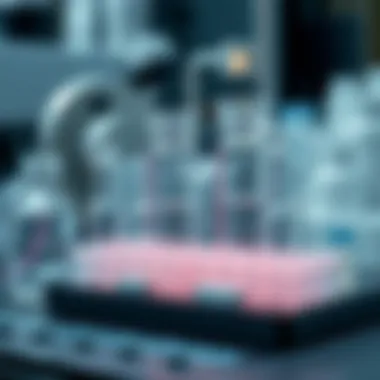Analytical Method Development for HPLC Techniques


Intro
In the world of analytical chemistry, few processes are as sophisticated and critical as High-Performance Liquid Chromatography (HPLC). This pivotal technique is the backbone of numerous applications, ranging from pharmaceuticals to environmental monitoring. Not just any approach will do; the quest for precise and reliable analytical results calls for well-thought-out methods tailored to specific needs.
This article takes a deep dive into the nuanced art and science of analytical method development for HPLC. For students, researchers, educators, and professionals alike, the emphasis here is on synergy between method optimization and practical implications. Whether you're selecting a solvent or determining the most suitable detector for your analysis, each decision can make or break your results. We're not just talking about tedium here; it’s about understanding the layers and variables at play in the development of robust HPLC methods.
So, fasten your seatbelt as we unravel the different strands of method development, from its scientific foundations to the nitty-gritty challenges one might face in real-world applications. This comprehensive overview aims to equip professionals with both theoretical knowledge and practical insights, ensuring compliance with industry standards and fostering excellence in analytical practices.
Prolusion to HPLC
High-Performance Liquid Chromatography (HPLC) stands as one of the cornerstones in analytical chemistry, marking its importance with a significant presence in both academic and industrial research. The precision that HPLC offers translates to unerring accuracy in quantitating compounds, making it invaluable across various fields like pharmaceuticals, environmental monitoring, and food safety. This article aims to shed light on the nuances of method development pertaining to HPLC, equipping researchers, educators, and industry professionals with the necessary tools for effective analysis.
The topic of HPLC takes center stage due to several compelling reasons:
- Versatility: HPLC can be utilized to analyze a broad range of substances, from small organic molecules to large biomolecules.
- Sensitivity: It can detect compounds present in minute concentrations, which is critical in fields that demand stringent quality control.
- Speed: Compared to traditional methods like GC (Gas Chromatography), HPLC often delivers faster results without sacrificing resolution or accuracy.
To harness these advantages, method development becomes imperative. It ensures that the HPLC system is operating at peak efficiency and can reliably yield consistent results. Each stage of the development process—ranging from solvent selection to detector choice—plays a crucial role in determining the success of a chromatography run.
Fundamentals of High-Performance Liquid Chromatography
High-Performance Liquid Chromatography operates on a simple premise: separating mixtures into their individual components. The technique entails pumping a liquid solvent (mobile phase) through a column packed with stationary phase material. The sample mixture is injected into the mobile phase, and based on the interactions between the molecules in the sample and the stationary phase, compounds get separated.
HPLC's effectiveness relies on the differences in physical or chemical properties of the analytes, such as:
- Polarity: A primary factor influencing how compounds interact with the stationary phase.
- Molecular size: Larger molecules may interact differently compared to their smaller counterparts.
- Hydrophobic characteristics: Determines how well a compound retains within the column.
Successfully harnessing these properties leads to enhanced resolution and sensitivity, which is key to robust analytical methods.
Historical Development of HPLC Techniques
HPLC has an interesting history of evolution, tracing back to the late 1960s. It emerged from earlier column chromatography methods, which were often limited by their inefficiencies. The introduction of high-pressure systems revolutionized this landscape. Here are some milestones in HPLC's history:
- 1967: The first commercial HPLC system was launched, which significantly improved efficiency and reproducibility.
- 1980s: The development of specialized columns, such as those made of silica, pushed the boundaries of separation capability further.
- 1990s onwards: The integration of detectors like mass spectrometers facilitated a deeper understanding of molecular structures, embracing a new realm of analysis.
This trajectory highlights a consistent push towards enhancing the specificity and sensitivity of HPLC methods. The advances made over the years have not only paved the way for fine-tuning existing techniques but also opened up avenues for new applications in various fields of study. As scientists continue to refine HPLC methodologies, its relevance in the analytical landscape remains undisputed.
Importance of Method Development
In the realm of High-Performance Liquid Chromatography (HPLC), method development stands as a cornerstone for achieving reliable and precise analytical results. The importance of systematically developing methods cannot be overstated. Crafting a robust analytical method not only ensures that the results are of high quality but also serves as a foundation for advancing scientific knowledge and meeting regulatory requirements.
Role in Scientific Research
The role of method development in scientific research is tantamount to laying down the tracks before a train can run smoothly. HPLC is often employed to analyze complex mixtures, detect impurities, or quantify active substances. Without a well-defined method, the validity of results could be compromised. Let's think about environmental studies using HPLC; if the detection method is not streamlined, pollutants might go unnoticed, skewing data critical for public health assessments.
In addition, researchers often rely on HPLC to uncover new findings. For instance, detecting novel biomarkers in clinical samples demands highly specific and sensitive methods. Thus, method development meets both the scientific requirement for rigorous standards and the practical necessity for reproducibility. Without reliable methods, laboratories could find themselves chasing their tails, revisiting experiments that ought to have been conclusive.
"The quality of results in HPLC is directly proportional to the effort invested in method development."
Applications in Pharmaceutical Analysis
In pharmaceutical analysis, the stakes are even higher. Here, method development not only ensures compliance with strict regulatory guidelines but also plays a pivotal role in safeguarding consumer safety. When developing an assay for a new drug, it becomes crucial to ascertain that the product is both effective and free from harmful impurities. HPLC is often employed to check the purity of a pharmaceutical compound before it reaches consumers.
Furthermore, patenting new drug formulations heavily relies on the reproducibility and reliability of analytical methods. A product with inconsistent analytical results may lead to unfavorable outcomes, like product recalls or legal complications, thereby costing both time and significant financial loss.
In summary, the importance of method development in HPLC extends across various domains. It not only bolsters the scientific community by advancing research but also upholds ethical standards in pharmaceuticals. Researchers and practitioners must understand that method development is not merely an initial phase; it is an ongoing commitment to quality, efficiency, and integrity in analytical chemistry.
This foundational phase of HPLC applications shapes the landscape of research and industry, marking its relevance as an indispensable practice.
Principles of Analytical Method Development
In the realm of analytical chemistry, particularly when it comes to High-Performance Liquid Chromatography (HPLC), the Principles of Analytical Method Development hold significant importance. These principles not only frame the methodology but also guide the research by ensuring the results are consistent, reliable, and applicable across various substances. Developing a robust HPLC method involves careful consideration of numerous factors that can enhance the accuracy and precision of the analysis.
Central to analytical method development is the need for clear and defined objectives. Without knowing what you aim to achieve, it’s akin to navigating a ship without a compass. Establishing specific goals allows for efficient resource allocation, guiding the selection of instruments and techniques tailored to the requirements of the analysis.
Define Objectives and Goals
Defining objectives is crucial as it lays the groundwork for all further processes in method development. For instance, if a researcher aims to quantify a specific compound within a complex matrix, it’s pivotal to outline this goal clearly. This clarity not only shapes subsequent parameters but also streamlines validation.
Taking time to draft objectives can also make the process of method development more systematic. Without this structure, efforts can become disjointed, leading to wastage of time and materials. Identifying the type of analytes, matrix effects, and the purpose of the study should be part and parcel of this stage. Additionally, researchers often need to ask themselves questions like:
- What is the nature of the samples?
- Are there any known interferences?
- What is the required detection limit?
Selecting Parameters for Optimization
Once objectives are defined, the next step is the meticulous selection of parameters for optimization. Doing this right can save a ton of headache down the line. Several variables come into play, and among them are pH levels, temperature control, and flow rates. Each of these elements plays a significant role in how effective and reproducible the results will turn out.
pH Levels
When it comes to HPLC, pH levels are a key factor. The pH of the mobile phase can dramatically affect the retention and separation of analytes. For instance, acidic or basic compounds can behave differently depending on the medium's acidity or alkalinity. What makes pH adjustments particularly beneficial is their ability to enhance selectivity during separations. A well-chosen pH can promote better ionization of an analyte, allowing for clearer signals and sharper peaks in chromatograms. However, one must be cautious as extreme pH values can also lead to column degradation or altered sample states.
Temperature Control
Next up is temperature control. The right temperature can facilitate quicker detections and improved resolution in chromatographic techniques. Temperature affects viscosity and, consequently, the flow rate of the mobile phase. Using elevated temperatures often helps to reduce the elution time significantly, which is vital in high-throughput settings. A unique advantage here is the potential for rapid method development, as varying temperature can help to tease apart closely eluting peaks. However, as with all parameters, there’s a fine line. Not every sample can withstand increased temperatures without decomposition.
Flow Rates
Last but not least, we have flow rates. This parameter can make or break the method's efficiency. A proper flow rate ensures that the mobile phase carries the analyte through the column at an ideal speed, balancing between time efficiency and resolution. Too fast can lead to poor separation, while too slow can cause longer run times. The beauty of optimizing flow rates lies in its direct correlation with pressure, meaning that tweaking flow rates can help manage the system's overall pressure. This control can assist in preventing potential issues, such as column overload or damaged detectors, which may arise from exceeding operational limits.
In essence, each parameter in analytical method development holds its own weight. By thoughtfully defining objectives and diligently selecting optimization parameters, researchers stand a better chance of navigating the intricacies of HPLC with precision and accuracy.


Choosing the Right Columns
Selecting the appropriate column is a crucial step in the analytical method development for High-Performance Liquid Chromatography (HPLC). The choice of column significantly influences the separation efficiency, resolution, and overall performance of the HPLC system. Each type of column serves different purposes and works optimally under specific conditions. Therefore, understanding the nuances between column types, their characteristics, and the selection criteria is essential for achieving accurate and reliable results in analytical applications.
Types of Columns
Reversed-Phase Columns
Reversed-phase columns are often considered the workhorses of HPLC. They utilize a non-polar stationary phase and a polar mobile phase, enabling effective separation of a wide array of compounds. This configuration is particularly advantageous for molecules that are moderately polar or non-polar, such as many pharmaceuticals and environmental samples. The key characteristic that sets reversed-phase columns apart is their hydrophobic interaction mechanism, allowing for better retention of non-polar analytes.
The popularity of reversed-phase columns lies in their versatility and reliability. As they can handle a variety of samples without extensive modifications, they are frequently the first choice in HPLC method development.
However, there are some considerations to keep in mind. For instance, the column can be susceptible to contamination from organic solvents, which might affect the analyte’s retention time and peak shape.
Normal-Phase Columns
In contrast, normal-phase columns feature a polar stationary phase and a non-polar mobile phase. These columns are particularly useful for separating polar compounds or when reversed-phase HPLC is ineffective. The key characteristic of normal-phase columns is their affinity for polar analytes, offering a distinct separation characteristic when compared to reversed-phase options. This can be especially beneficial when dealing with complex mixtures, such as sugars, amino acids, or certain lipids.
Despite their usefulness, normal-phase columns tend to have disadvantages as well. They require careful solvent selection, as the non-polar mobile phase can lead to reduced solubility for some analytes. Additionally, they often culminate in longer run times due to weaker interactions with less polar substances.
Column Characteristics and Selection Criteria
When it comes to selecting a column, various factors must be considered:
- Particle Size: Smaller particles enhance separation efficiency but can lead to higher back pressure.
- Pore Size: Important for large analytes; ensure the pores accommodate the molecular size of targeted compounds.
- Surface Chemistry: Different modifications can tailor the polarity of the column, aligning better with analytes.
- Length and Diameter: These dimensions affect the resolution; longer columns typically provide better separation but require longer run times.
"The art of choosing the right columns can make the difference between a mediocre separation and one that truly shines"
Solvent Selection in HPLC
When diving into the world of High-Performance Liquid Chromatography (HPLC), the decision of which solvent to use is nothing short of pivotal. Solvent selection can impact the separation quality, resolution, and even the longevity of the analytical method. Choosing the right solvent isn't just about what looks good on paper; it is about understanding the interactions between solvents and solutes as well as how those interactions affect the entire chromatographic process.
Properties of Solvents
Solvents come with their unique properties that dictate their effectiveness in HPLC applications. Key characteristics include polarity, viscosity, boiling points, and the capacity for interacting with various sample matrices. For instance, polarity significantly affects solute solubility and retention time, making it a must-consider factor when selecting a solvent. More polar solvents like methanol serve well in separating highly polar compounds while less polar options such as hexane can effectively separate non-polar substances. Thus, knowledge of these properties is fundamental when aiming for precision in method development.
Miscibility and Compatibility
When considering solvent selection, miscibility and compatibility play crucial roles in avoiding issues such as phase separation and precipitation under HPLC conditions.
Polar vs Non-Polar Solvents
Polar solvents, like acetonitrile and methanol, are widely identified for their ability to solvate ionic species and highly polar compounds efficiently. A critical feature of polar solvents is their ability to establish hydrogen bonds, enhancing interaction with analytes possessing polar functional groups. This results in better peak shape and resolution in chromatograms.
On the flip side, non-polar solvents such as hexane and toluene are preferable when dealing with hydrophobic substances. These solvents offer lower viscosity, which can lead to faster flow rates and reduced pressure in the HPLC system. However, the trade-off is that they may not dissolve polar analytes effectively, which can lead to suboptimal separation and detection of such compounds.
Thus, selecting between polar and non-polar solvents can dictate the number of peaks and the clarity of results in chromatography, directly contributing to method reliability and efficacy.
Buffer Systems
Buffer systems are an essential aspect of solvent selection in HPLC. They help to stabilize the pH of the mobile phase, which is crucial because a stable pH can lead to consistent retention times and improved reproducibility across multiple runs. The key characteristic of buffer systems lies in their ability to resist changes in pH, thus maintaining the ionization state of the analytes during separation.
For instance, using phosphate buffers can effectively enhance the stability of basic compounds while citric acid buffers serve well for acidic analytes. One unique feature of buffer systems is that they enable chemists to fine-tune the chromatography conditions by adjusting the ionic strength or pH to achieve an optimal environment for analyte separation.
However, selecting the wrong buffer can create additional complications, such as interfering with detection methods or causing precipitation of the buffer salts.
In summary, solvent selection in HPLC isn't merely a box to check; it’s a complex decision-making process that impacts method development from numerous angles. Whether you're dealing with the choice of polar versus non-polar solvents or deciding on a suitable buffer system, each choice carries weight since it contributes significantly to achieving accurate and reliable analytical results.
Method Validation Protocols
In the realm of High-Performance Liquid Chromatography (HPLC), method validation serves as a cornerstone for ensuring credibility and consistency in analytical results. This process is not merely a formal step; it is a critical framework that underpins the reliability of data across various applications. Ensuring that methods deliver results that are accurate, precise, and reliable is of paramount importance, particularly in fields like pharmaceuticals where every data point holds substantial significance. Validation protocols offer a systematic way to benchmark these methods and confirm that they meet requisite performance characteristics.
Key Validation Parameters
Accuracy
Accuracy represents how close a measured value is to the true value or a standard. In the context of HPLC, this means how well a test gives results that align with known standards. High accuracy reduces the likelihood of erroneous conclusions that can arise from poor data quality. It’s especially crucial when developing new analytical methods since it can affirm the method’s efficacy before it's employed in complex studies. The essential characteristic of accuracy involves the systematic error, or bias, which can skew results significantly if not managed.
One might consider accuracy a popular choice in quality assurance because it directly affects the interpretation of results. However, achieving accuracy often requires meticulous calibration against standards, which demands diligent attention to detail and rigorous methodologies. Its unique feature is the need for a well-defined reference standard. While striving for high accuracy can ensure robust data, it can also lead to intricacies associated with standards that may not always represent the full spectrum of analytes present in samples.
Precision
Precision, on the other hand, deals with the reproducibility of results. It defines how consistently a method produces the same results under unchanged conditions. In HPLC, high precision indicates that repeated analyses yield results which are closely grouped together, reflecting the method’s reliability over time. This characteristic is valuable, particularly when running multiple samples or prolonging studies, as it mitigates variability that can arise from factors like operator differences or equipment inconsistencies.
The merit of precision lies in its ability to offer a level of confidence in repeated measurements. However, one should be cautious; a method can be precise but not necessarily accurate. This means a consistently wrong outcome can mislead researchers if not evaluated against accuracy measures. Its unique attribute is that some methods might achieve high precision without thorough validation, leading to a potential false sense of security.
Linearity
Linearity relates to the method’s ability to produce results that are directly proportional to the concentration of the analyte within a given range. This property is vital for quantitative analyses as it delineates the dynamic range in which the method can effectively facilitate accurate quantitation. Having a linear relationship enables quick assessments of concentration levels by leveraging established correlations, thus simplifying data interpretation in lengthy research processes.
The key characteristic of linearity is its straightforwardness; it encourages the use of standard curves for quantitative analysis in HPLC. A well-defined linear range can drastically improve the workflow, making it a beneficial parameter for researchers to bear in mind. Despite its advantages, challenges may arise if the linearity is established based on a limited number of standards, which may not reflect the true behavior of analytes in more complex matrices.
Regulatory Guidelines for Validation
Navigating the labyrinth of regulatory guidelines is a necessity in the validation process. Various agencies set forth stringent criteria that dictate how method validations should be carried out to ensure comprehensive reliability and credibility. In many cases, these guidelines serve as vital touchstones for laboratories in maintaining adherence to best practices in method development.
Key organizations involved include the U.S. Food and Drug Administration (FDA), European Medicines Agency (EMA), and the International Conference on Harmonisation (ICH). Each of these organizations provides detailed documentation that outlines requisite validation parameters and methodologies.
"Adhering to regulatory guidelines not only fortifies the integrity of research but also protects public health by ensuring compliance with safety standards."


Familiarity with these regulations equips researchers with the knowledge required to design appropriate studies that effectively meet the standards expected by governing bodies, helping to pave the way for clear communication of results. Assuring compliance is not merely an obligation; it's a safeguard against potential repercussions that could spring from unvalidated methods, underscoring the importance of rigorous validation protocols in HPLC method development.
By carefully considering these aspects of method validation, researchers can enhance the robustness of their analytical methods, thereby ensuring fidelity and reliability in HPLC applications. The delicate balance of achieving high accuracy, precision, and linearity, while aligning with regulatory expectations, underscores the intricate nature of method validation and highlights its pivotal role in the development of trustworthy HPLC methods.
Optimization Techniques
Optimization techniques play a pivotal role in analytical method development for High-Performance Liquid Chromatography (HPLC). These techniques are essential in refining processes to achieve desired outcomes, ensuring precise and accurate results that are crucial for both research and industrial applications. By systematically improving the conditions under which HPLC operates, researchers can mitigate the risks of errors and enhance the reproducibility of analyses.
The main goal of optimization is to identify the best parameters that govern the separation of analytes. This involves careful consideration of aspects such as column selection, solvent composition, and operational conditions. The benefits of well-implemented optimization strategies include reduced run times, enhanced resolution, and improved sensitivity of detection methods. Working through these strategies helps to cultivate a deeper understanding of the system being studied and facilitates the discovery of new applications for HPLC methodologies.
Experimental Design Approaches
Response Surface Methodology
Response Surface Methodology (RSM) stands out as a powerful statistical technique used for optimizing HPLC methods. The primary focus of RSM is to explore and model the relationship between multiple independent variables and one or more response variables. This approach provides a structured way to evaluate how changes in parameters affect outcomes, enabling researchers to fine-tune their methods effectively.
One key characteristic of RSM is its ability to handle interactions between variables. Instead of tweaking one factor at a time, which can be cumbersome and time-consuming, RSM surveys a multidimensional space, offering insights into interactions that might otherwise be overlooked. This flexibility makes it a popular choice for method optimization.
A unique feature of RSM lies in its graphical representations, often in the form of contour plots or 3D surfaces. These visual aids help researchers easily identify optimal parameter combinations. However, it’s important to recognize that while RSM can yield insightful results, the methodology may also introduce complexity. Dealing with multiple variables can complicate the interpretation of data, necessitating a strong foundational understanding of statistical principles.
Factorial Design
Factorial Design is another crucial experimental design method used for optimizing HPLC techniques. This approach involves systematically varying multiple factors to assess their individual and collective effects on desired outcomes. The strengths of factorial design lie in its robustness and efficiency, particularly when dealing with numerous variables that could impact method performance.
A primary characteristic of factorial designs is their comprehensive approach. By examining all possible combinations of factors, researchers can gather extensive data that reveal significant interactions. This thorough examination of variables enables researchers to identify specific conditions under which their methods will perform best, making it a practical and popular option for analytical method development.
A distinguishing feature of factorial design is its ability to produce high-quality interaction estimates, allowing researchers to draw meaningful conclusions about how various factors interplay. However, there are downsides to consider. As the number of factors increases, the complexity of the experiment can escalate dramatically, leading to longer run times and the potential for overwhelming amounts of data. Adequate planning and clear objectives are crucial in harnessing the benefits of factorial design without becoming mired in its complexity.
Implementing Software for Optimization
The advent of modern software tools has revolutionized the way optimization is approached in analytical method development. Various software applications provide researchers the capability to analyze data effectively, running simulations and modeling outcomes based on user-defined parameters. This technological support not only streamlines the optimization process but also enhances the accuracy of predictions.
Using software also allows researchers to benefit from advanced algorithms which can sift through complex data sets, identifying trends that might not be immediately apparent through manual analysis. Programs often include user-friendly interfaces, making them accessible even to those without extensive experience in data analysis.
Practical Challenges in Method Development
Navigating the technical waters of analytical method development in High-Performance Liquid Chromatography (HPLC) is no small feat. Method developers often confront several challenges that can hinder their analytical goals. Understanding these challenges is essential as it equips researchers and practitioners with strategies to tackle issues head-on, ensuring that method development yields robust, reliable, and reproducible results. In this section, we’ll delve into two primary hurdles that many developers face: matrix interference and scalability issues. Each of these challenges presents unique considerations that demand careful attention.
Matrix Interference
Matrix interference remains a significant concern during method development. Every sample matrix—be it biological fluids, food products, or environmental samples—contains its unique set of components that can obscure analyte detection. This interference can manifest in various ways, such as suppressing signal intensity or causing signal drift, which could lead to misconceptions about an analyte's concentration in a sample.
The art of method development is akin to finding a needle in a haystack; these disruptive components may easily mask or alter the response of the analyte of interest. To address this issue effectively, researchers may consider a few strategies:
- Sample Preparation Techniques: Employing solid-phase extraction (SPE), liquid-liquid extraction (LLE), or filtration can significantly enhance the purity of the sample prior to analysis, thus mitigating interference.
- Dilution: Although it may not be the perfect solution, diluting the matrix can reduce interference levels significantly, but it must be done judiciously to avoid compromising the analyte concentration.
- Selective Detection Methods: Utilizing advanced detection methods, such as tandem mass spectrometry, may help distinguish between the signal of the analyte and matrix components. This sophistication can be a game changer in achieving clean results.
Overall, rigorously addressing matrix interference ensures that analytical results are not merely statistical artifacts, but true reflections of the sample's composition.
Scalability Issues
Scalability issues pose another common thorn in the side of method developers. It is one thing to optimize an analytical method in a small-scale laboratory setting, but it is a whole different ball game when moving to industrial-scale production. Changes in scale can introduce various complications, including altered fluid dynamics and changes in temperature or pressure, which can significantly affect the reproducibility of results.
When establishing the scalability of an HPLC method, consider the following factors:
- Flow Rate Adjustments: As you scale up, maintaining consistent flow rates becomes critical. Variability in flow can lead to differences in resolution and retention times, thus affecting results.
- Column Size and Dimensions: Transitioning from a standard analytical column to a preparative scale column requires adjustments in dimensions and packing methods. This adaptation needs to retain the essential separation characteristics vital for accurate results.
- Sample Size: While larger sample sizes may seem advantageous, they can complicate mass transfer dynamics. The relationship between sample size and separation quality needs to be examined meticulously.
To sum it all up, overcoming scalability issues means balancing the need for higher throughput with the necessity of maintaining method integrity.
"The road of method development is strewn with challenges, but facing them with a robust strategy is the way forward toward analytical success."
For further reading and insights into analytical challenges, consider exploring resources such as Wikipedia or Britannica. You might also find engaging discussions in communities like Reddit or seek out academic articles on trusted domains like universities (.edu) or government (.gov) websites.
Types of Detectors in HPLC
In the realm of High-Performance Liquid Chromatography (HPLC), the choice of detector plays a pivotal role in determining the success of the analytical method. The detectors are essentially what helps researchers and practitioners quantify and identify the components within a sample. Each type of detector brings its own strengths and weaknesses, influencing its effectiveness and applicability to various analytical challenges. Understanding the different types of detectors, along with their respective benefits and drawbacks, is essential for optimizing outcomes in method development.
UV-Vis Detectors
Ultraviolet-Visible (UV-Vis) detectors are among the most widely used in HPLC. The commonality of their use can be attributed to their effectiveness, simplicity, and affordability. These detectors operate by measuring the absorbance of UV or visible light by a sample as it passes through a flow cell. The core benefit here is the ability to detect a wide range of compounds, especially those that contain chromophores, which absorb light in the UV spectrum.
Some important points regarding UV-Vis detectors include:
- Sensitivity and Range: While UV-Vis detectors can detect concentrations as low as parts per million (PPM), the specific sensitivity varies based on the wavelength and the nature of the analyte. For instance, aromatic compounds tend to reflect strong absorbance, making detection straightforward.
- Limitations: Not all compounds can be analyzed using UV-Vis detectors. Analytes that do not absorb UV light—such as many aliphatic hydrocarbons—can be notoriously elusive using this method. Hence, researchers often need to rely on complementary techniques or enhance their methods.
- Gradient Compatibility: UV-Vis detectors readily accommodate gradient elution, making them versatile for various HPLC scenarios. However, care must be taken in method development to ensure the detector operates within its specific limits of wavelength and temperature.
"A good UV method cannot be further enhanced if the foundational detection mechanism is weak. Results hinge not just on the data collected but on what you collect it with."
Mass Spectrometry Integration
The integration of Mass Spectrometry (MS) into HPLC has revolutionized the field of analytical chemistry. When coupled with an HPLC system, mass spectrometry offers powerful capabilities for the structural elucidation of compounds and provides quantification at an unparalleled level. This technology measures ions based on their mass-to-charge ratio, allowing for the identification of compounds even in complex mixtures.
Key aspects of Mass Spectrometry Integration include:
- Detailed Analysis: Mass spectrometers can provide relevant information regarding molecular weights, structural characteristics, and fragmentation patterns, which is invaluable for method development where analytical depth is required.
- Sensitivity and Selectivity: The sensitivity of mass spectrometric detection often surpasses that of UV detectors, allowing for the detection of compounds at lower concentrations. This is particularly beneficial in pharmacokinetic studies or trace analysis.
- Data Complexity: Although mass spectrometry offers richer data, the complexity of interpreting this data can be daunting. Thus, it requires researchers to be well-versed in not only the analytical methodology but also in data analysis techniques.
- Cost and Equipment Considerations: While MS provides advanced capabilities, it necessitates a more significant upfront investment in both equipment and required expertise. Balancing this cost against the analytical need is crucial during method development.
In summary, understanding Types of Detectors in HPLC is fundamental for researchers aiming to explore the nuances of their samples effectively. Both UV-Vis and Mass Spectrometry detectors offer unique advantages that can influence not just the method's performance, but also the validity of the analytical results.
For more in-depth information, various resources such as Wikipedia on Mass Spectrometry and Analytical Chemistry can serve as useful references.
Data Analysis and Interpretation


The realm of analytical method development for High-Performance Liquid Chromatography (HPLC) reaches a crucial juncture when it comes to data analysis and interpretation. Proper analysis not only confirms the efficacy of the methods but also ensures the reliability of the results produced. Understanding how to extract meaningful insights from raw data is fundamental for researchers and analysts alike. Through well-executed data interpretation, professionals can ascertain the effectiveness of their methods, understand their linearity and precision, and ultimately trust their findings.
Software Tools for Data Analysis
In this age of technology, a myriad of software tools are at the disposal of researchers for analyzing HPLC data. These tools can handle complex datasets, allowing for the swift interpretation of chromatograms and generation of reports. Software such as Agilent OpenLab, Waters Empower, and Thermo Scientific Chromeleon provide robust features for data manipulation and statistical analysis.
Here are some specific benefits of utilizing these software tools:
- User-friendly Interfaces: Designed to cater to users of varying expertise, offering intuitive navigation.
- Automated Data Processing: Reduces the manual workload, allowing for efficiency in large data sets.
- Statistical Functions: Built-in algorithms help assess method validation parameters like ruggedness and stability.
- Graphical Representations: Visual aids such as overlays and signal peaks assist in setting an analytical narrative.
Moreover, using tools with cloud capabilities can enhance collaborative efforts among teams, ensuring data integrity is maintained throughout the research process.
Interpreting Chromatograms
Chromatograms serve as a window into the analytical process. They present the interaction of substances as signals over time, displaying retention times and peak patterns. Skilled interpretation of these graphs is imperative. Here are key aspects to consider while analyzing a chromatogram:
- Baseline Stability: Any fluctuations in the baseline can indicate noise or interferences that might skew the results.
- Peak Area and Height: These metrics give insight into the concentration of analytes. The area, in particular, is often more reliable than peak height due to its integration over time.
- Retention Time: Consistency of retention times across repeated tests can validate results. Variation could point to an issue in method execution or sample integrity.
- Split Peaks and Tailings: These phenomena can hint at column issues or improper solvent interactions, indicating the need for method adjustments.
Interpreting chromatograms is not just about reading the peaks. It involves critical thinking and an understanding of the chemistry involved. Data analysis and interpretation is the life blood of HPLC; without it, the journey of research takes a detour into ambiguity.
To summarize, data analysis and interpretation are not just final steps in HPLC method development; they are an ongoing dialogue with the data. This conversation helps guide further experiments, ensure compliance with regulatory standards, and refine applications in both industry and research environments.
Case Studies in HPLC Method Development
In the realm of High-Performance Liquid Chromatography (HPLC), case studies serve not just as anecdotal reports but as critical touchstones that underscore the efficacy of method development practices. They illustrate real-world applications of theoretical principles, bringing life to the numerical data through practical implications. These case studies offer invaluable insights into the nuances of HPLC techniques, showcasing how specific challenges are navigated, what approach was taken, and the outcomes achieved. Understanding the intricacies involved in these case studies can greatly assist researchers and professionals in formulating more reliable and robust methods for their own analytical needs.
- Highlighting Practical Applications: Case studies demonstrate how HPLC can be effectively utilized across various industries, underscoring its versatility.
- Learning from Challenges: They reveal common pitfalls encountered during method development and the strategic problem-solving employed to overcome them.
- Benchmarking Standards: These examples also provide a framework for assessing method validation and optimization, thereby establishing performance benchmarks.
When looking into the development of analytical methods through case studies, we can get a better picture of how things work in the lab and also understand the importance of maintaining accuracy and compliance with regulatory standards.
Development of a Drug Assay Method
The development of a drug assay method highlights the complexity and precision required in pharmaceutical research. One notable case involved the analysis of a new antidiabetic drug. The aim was to create an HPLC method that could accurately quantify the drug in plasma samples while ensuring minimal interference from other substances.
A step-by-step approach was employed:
- Sample Preparation: Plasma samples were extracted using solid-phase extraction, ensuring high purity levels before HPLC analysis.
- Column Selection: A reversed-phase C18 column was chosen due to its ability to separate non-polar compounds effectively, essential for the hydrophobic nature of the drug.
- Validation Parameters: Key validations were conducted, including accuracy, precision, limit of detection, and linearity, ensuring reliable results.
The developed method not only provided accurate quantification but also expedited the drug development process, enabling timely clinical trials. This case study serves as a hallmark for future drug assay methods, emphasizing the importance of systematic development and validation processes in achieving regulatory compliance and scientific credibility.
Environmental Samples Analysis
Environmental monitoring is yet another area where HPLC's capabilities shine. A case study focused on the detection of persistent organic pollutants (POPs) in water samples taken from a lake affected by industrial runoff.
The method developed for this analysis involved a thorough understanding of both the environmental matrix and the chemical properties of the pollutants:
- Matrix Interference Concerns: Initial tests revealed that organic matter in the water interfered with detection. Thus, a complex extraction and clean-up process was implemented.
- Optimization of Solvent Systems: A mixture of methanol and water was chosen based on its ability to extract target pollutants without compromising their integrity during the analysis.
- Analysis Technique: A combination of UV-Vis detection and mass spectrometry was used to enhance sensitivity and specificity, enabling the accurate identification of trace levels of POPs.
The results from this case study paved the way for improved environmental assessments and reinforced the reliability of HPLC in environmental analyses. By showcasing the effective application of HPLC in real-world scenarios, these studies not only enhance scientific understanding but also inspire confidence in the methodology among practitioners in diverse fields.
Through case studies, researchers can learn how to adeptly navigate the complexities of analytical method development, improving both their skills and the reliability of their results.
Future Trends in HPLC Method Development
As the landscape of analytical chemistry evolves, High-Performance Liquid Chromatography (HPLC) remains at the forefront. The importance of examining future trends in HPLC method development cannot be overstated. With advances being made in technology and increasing demands for precision in various fields, method development is constantly adapting. Researchers, educators, and professionals eyeing the latest innovations receive timely insights on enhancing their methodologies.
Advances in Column Technology
Column technology has come a long way since the advent of HPLC. The performance of an HPLC system heavily relies on the quality and design of the column used. Recent advancements focus on several key areas:
- Ultra-High-Performance Liquid Chromatography (UHPLC): This trend has garnered attention for its ability to significantly reduce analysis time without compromising the resolution. UHPLC columns with smaller particle sizes enhance separation efficiency.
- Monolithic Columns: These offer a unique advantage due to their large surface area and support for high flow rates. The streamlined design allows for faster equilibration and reduced back pressure, making them a favorable option for complex mixtures.
- Chiral Columns: There is a growing demand for chiral separations, particularly in pharmaceutical applications. Innovations in chiral stationary phases are allowing for quicker and more effective separations of enantiomers.
- Biocompatible Columns: As the pharmaceutical industry shifts toward biologics, biocompatible columns are becoming vital. These columns are designed to handle sensitive biomolecules without degrading them during the analysis process.
The future of column technology focuses on enhancing separation mechanisms, improving reproducibility, and offering more versatility depending on the analyte properties.
Integration of Artificial Intelligence
Artificial Intelligence (AI) is making waves across numerous industries, and HPLC method development is no exception. Integrating AI into HPLC provides several benefits:
- Data Management: AI algorithms can handle vast amounts of data generated during HPLC analyses. Machine learning models can interpret these datasets to identify patterns, making analysis faster and more efficient.
- Predictive Modeling: Researchers are increasingly using AI to predict optimal method parameters based on historical data. This data-driven approach reduces the trial-and-error nature of method development, leading to quicker results.
- Automated Method Development: AI-powered systems can automate the process of method development. With the ability to explore multiple variables and configurations simultaneously, these systems optimize conditions faster than manual efforts could achieve.
- Enhanced Troubleshooting: AI tools assist in diagnosing problems that may arise during analyses, from instrument malfunctions to method inefficiencies. This can significantly reduce downtime and improve the reliability of analytical results.
The synergy between AI and HPLC offers a glimpse into a future where method development is more streamlined, precise, and user-friendly.
"Future trends in HPLC method development will not just influence the technology, but will also redefine the strategies and approaches used for analytical processes."
In light of these advancements, it becomes essential for professionals in the field to stay updated on emerging technologies and consider their applications in evolving methodologies. Engaging with these trends prepares researchers to tackle new challenges and harness the benefits that innovative technologies offer. By doing so, they advance not only their practices but also contribute to the broader scientific community.
Ending
The conclusion of this article serves as a pivotal moment to reflect on the multifaceted discipline of analytical method development in High-Performance Liquid Chromatography (HPLC). In an era where precision and accuracy are not simply desired, but demanded, comprehending the essentials discussed throughout has profound relevance for students, researchers, educators, and professionals alike. A solid grasp of this topic fortifies one's skills to engage in efficient analytical practices, while also steering scientific inquiry in productive directions.
Summarizing Key Learnings
As we wind down our exploration, several salient points emerge from our investigation:
- Method Development is Systematic: Establishing a robust analytical method may not be a walk in the park. It's a meticulous process requiring clarity of objectives, choice of appropriate parameters, and fine-tuning of various elements to hone in on the ideal conditions.
- Optimization is Crucial: Various techniques, including response surface methodology and factorial designs, are pivotal in optimizing method parameters. Utilizing modern software tools streamlines this process significantly.
- Validation is Non-Negotiable: Accuracy, precision, and linearity are crucial validation parameters, ensuring that methods can be reliably employed in real-world applications. Adhering to regulatory guidelines cannot be ignored either.
- Emerging Technologies Promise Evolution: The landscape of HPLC continues to evolve. Advances in column technology and the incorporation of artificial intelligence are indicative of a shift that will refine, perhaps even revolutionize, analytical practices in the near future.
"The future depends on what you do today." - Mahatma Gandhi
Implications for Future Research
The insights gleaned from this article extend well beyond immediate applications. They provide a sturdy foundation for future research endeavors. Here’s how:
- Translational Applications: The principles of method development can be adapted and applied across various domains, from pharmaceuticals to environmental science, paving the way for innovative solutions to real-world problems.
- Continued Advancement of HPLC Techniques: Researchers are encouraged to explore how the integration of artificial intelligence and machine learning can transform traditional methods, improving efficiency and possibly even revealing nuanced data that may have been overlooked.
- Collaboration Across Disciplines: Cross-pollination of ideas between fields, such as chemistry and data science, can lead to breakthroughs in analytical techniques.
- Addressing Emerging Challenges: With an increasing focus on sustainability, future research should explore greener solvents and more eco-friendly practices within method development.
In closing, the art of HPLC method development is not merely an academic pursuit. It carries the potential to yield valuable insights that can influence a variety of industries, ultimately contributing to advancements in health, safety, and environmental protection.







